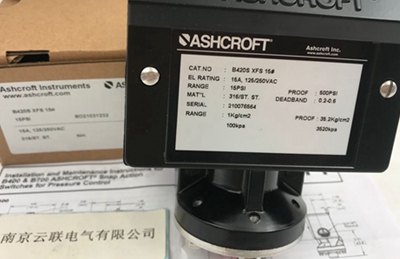
Telephone
025-52791167,52791168
13390905858
13390905858

Reasons and troubleshooting methods for ASHCROFT pressure gauge faults
1. Pointer zeroing failure, large zero position error
During the use of a force gauge, there is often a situation where it does not return to zero. In the absence of external negative pressure, the pointer of the force gauge will point to a pressure reading. If there is a deviation value
If measurement is allowed, it will cause significant interference to the measurement results, affect production or daily life, and even lead to the occurrence of safety hazards. The causes and troubleshooting of pressure gauge failure to return to zero
The methods for troubleshooting are as follows:
(1) The pressure load pressure is too high, causing the deformation of the spring tube shape to exceed the allowable value of the elastic coefficient, resulting in non rebound deformation. The solution to this type of malfunction is to remove the pointer,
Point the pointer to the zero position and reinstall for testing. If the performance still does not meet the requirements after calibration, the spring tube needs to be replaced;
(2) The pressure gauge shows shaking phenomenon- Usually, due to the loosening of the fixing screws on the pressure gauge, use a tool to tighten the installation screws;
(3) The gear inside the pressure gauge is dislodged. Usually, it is caused by the insufficient number of meshing teeth between the pressure gauge sector gear and the gear shaft. It is necessary to disassemble the pressure gauge to replace the gear and adjust the teeth properly
The number of teeth engaged between the wheel and gear shaft;
(4) The pointer indicates deformation at the end. The fault is mainly caused by excessive changes in the load pressure of the pressure gauge, which requires disassembling the pressure gauge to replace the pointer;
(5) Work – After a period of time, the internal cavity is blocked and the channel needs to be cleaned.
2. The indicator end of the pointer is located after the zero stop pin
After working for a period of time, the force gauge occasionally experiences a phenomenon where the pointer indicator end is located behind the zero stop pin inside the dial. The fault is mainly due to the excessive distance between the pointer of the pressure gauge and the dial
When the pressure gauge vibrates violently, the pointer may skip the stop pin and cannot reset itself after jumping to the stop pin due to the large or insufficient strength of the pointer. The solution is to gently remove the pressure
Protect the watch cover by lifting the pointer to the zero stop pin and adjusting the distance between the pointer and the dial to prevent the same malfunction from happening again
telephone:025-52791167,52791168
Fax:025-52791169
Phone :13390905858
mailbox:njxj888@163.com skype:yluedq
Address:Jiangning Shuanglong Avenue No.1222 Nanjing, Jiangsu. China P.O. 211100